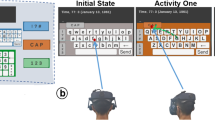Abstract
In recent times, smart devices equipped with small touch panels have become very popular. Many such smart devices use a software keyboard for character input. Unfortunately, software keyboards have a limitation: the number of buttons and the input degrees of freedom remain the same, because a button and an input value correspond one-to-one. Thus, if we reduce the screen size while the button size remains the same, the number of buttons must decrease. Alternatively, if we maintain the number of buttons and reduce the screen size, the size of the button decreases, making input increasingly difficult. In this study, we investigate a new character input method that is specifically adapted for use on small screens. The proposed input interface has 4 × 2 operational degrees of freedom and consists of four buttons and two actions. By handling two operations as one input, 64 input options are secured. Additionally, we experimentally evaluate the proposed character input user interface deployed on a smart device. The proposed method enables an input of approximately 25 characters per minute, and it shows robust input performance on a small screen compared to previous software methods. Thus, the proposed method is better suited to small screens than were previous methods.





Similar content being viewed by others
References
Cisco Visual Networking Index: Forecast and Methodology, 2014–2019 White Paper. http://www.cisco.com/c/en/us/solutions/collateral/service-provider/ip-ngn-ip-next-generation-network/white_paper_c11-481360.html. Accessed 30 Apr 2017
Statistical distribution of time spent on apps on mobile devices in the United States in June 2015, by category. http://www.statista.com/statistics/248343/distribution-of-time-s pent-ios-and-android-apps-by-category. Accessed 30 June 2015
Katie A, Siek Y, Rogers, Kay H, Connelly (2005) Fat finger worries: how older and younger users physically interact with pdas. In: Proceedings the 2005 IFIP TC13 international conference Human–computer interaction (INTERACT), pp. 267–280
Mitsuhiro Y, Akihiko M, Mahilum JBKT (2013) Moving IME panel for text input method and Shapekey prototype. In: 2013 IEEE 2nd global conference on consumer electronics (GCCE), pp. 474–478
Hall A, Cunningham J, Roache R, Cox J (1988) Factors affecting performance using touch-entry systems: tactual recognition fields and systems accuracy. J Appl Psychol 73:711–720
Hamano Y, Nishiuchi N, (2013), Usability evaluation of text input methods for smartphone among the elderly. In: 2013 International conference on biometrics and kansei engineering (ICBAKE), pp. 277–280
Matsuno S, Akehi K, Itakura N, Mizuno T, Mito K (2015) Computer input system using eye glances. In: 17th International conference on human–computer interaction (HCII), August, pp. 425–432
Akehi K, Matsuno S, Itakura N, Mizuno T, Mito K (2015) Improvement in eye glance input interface using OpenCV. In: Proceedings of the international conference on electronics and software science (ICESS), Takamatsu, Japan, pp. 207–211
Chida S, Matsuno S, Akehi K, Itakura N, Mizuno T, Mito K (2016) A proposal and investigation of the character input method selecting a lot of choices by a few operation degrees of freedom for smart devices. In: The papers of technical meeting on optical and quantum devices. IEE Japan, pp. 31–34
Chida S, Matsuno S, Itakura N, Mizuino T (2016) Input interface suitable for touch panel operation on a small screen. In: 2016 IEEE region 10 conference (TENCON), pp. 3679–3683
Bellman T, MacKenzie IS (1998) A probabilistic character layout strategy for mobile text entry. Proc Graph Interface 98:168–176
Dunlop MD (2004) Watch-top text-entry: Can phone-style predictive text entry work with only 5 buttons?. In: Proceedings MobileHCI 2004, pp. 342–346
Dunlop MD, Masters MM (2008) Investigating five key predictive text entry with combined distance and keystroke modelling. Pervasive Ubiquitous Comput 12:589–598
Tanaka-Ishii K, Inutsuka Y, Takeichi M (2002) Entering text with a four-button device. In: Proceedings conference on computational linguistics, vol. 1, pp. 1–7
Gong J, Tarasewich P, MacKenzie IS (2008) Improved word list ordering for text entry on ambiguous keyboards. In: Proceedings NordiCHI 2008, pp. 152–161
Hiroyuki H, Yoshitomo F, Buntarou S, Jiro T (2015) Back-of-device interaction based on the range of motion of the index finger. In: OzCHI, pp. 202–206
Matsuura Y, Go K (2007), Behavioral characteristic of one-handed thumb operation of small touch screen devices. Hum Interface 9(4):455–461
Nakic-Alfirevic T, Durek M (2004) The Dvorak keyboard layout and possibilities of its regional adaptation. In: 26th international conference on information technology interfaces, vol. 1, pp 373–378
Hobday SW (1996) The Maltron keyboards, In: IEE colloquium on interfaces—the leading edge (Digest No. 1996/126), PCD Maltron Ltd, East Molesey, UK, pp. 801–810
Bi X, Smith BA, Zhai S, (2010), Quasi-qwerty soft keyboard optimization. In: Proceedings CHI2010, pp. 283–286
Go K, Endo Y (2007) CATKey: customizable and adaptable touchscreen keyboard with bubble cursor-like visual feedback. In: Human–computer interaction-INTERACT 2007, Part I, pp. 493–496
Aulagner G et al. (2010) “FloodKey: increasing software keyboard keys by reducing needless ones without occultation”. In: Proceedings ACS’10, Stevens Point, USA, pp. 412–417
Edelmann J et al. (2012) Towards the keyboard of Oz: learning individual soft-keyboard models from raw optical sensor data. In: Proceedings ITS’12, pp. 163–172
Mackenzie I, Scott (2009) The one-key challenge: searching for a fast one-key text entry method. In: Proceedings the 11th international ACM SIGACCESS Conference on computers and accessibility. pp 91–98
Pickering JA (1986) Touch-sensitive screens: the technologies and their application. Int J Man Mach Stud 25(3):249–269
Armstrong P, Wilkinson B (2016) Text entry of physical and virtual keyboards on tablets and the user perception. In: OzCHI, pp. 401–405
Author information
Authors and Affiliations
Corresponding author
Additional information
This work was presented in part at the 23rd International Symposium on Artificial Life and Robotics, Beppu, Oita, January 18–20, 2018.
About this article
Cite this article
Matsuno, S., Chida, S., Itakura, N. et al. A method of character input for the user interface with a low degree of freedom. Artif Life Robotics 24, 250–256 (2019). https://doi.org/10.1007/s10015-018-0512-4
Received:
Accepted:
Published:
Issue Date:
DOI: https://doi.org/10.1007/s10015-018-0512-4




